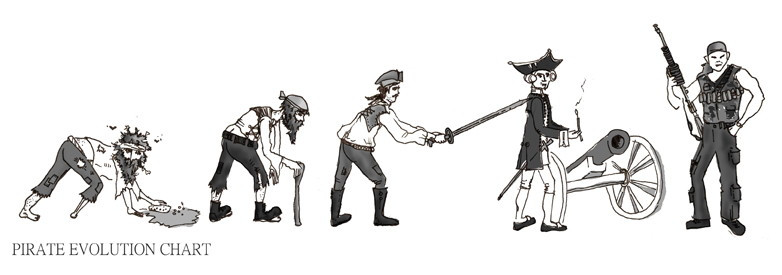Living like a pirate in modern times
There may be a big difference between the years 1709 and 2009, but being a pirate looks pretty similar
Pirate life, in many ways, hasn’t changed for 300 years.
Pirates off the coast of Somalia in the Gulf of Aden, bankrolled by landlubber warlords, threaten worldwide trade with a degree of fearlessness, organization and camaraderie that harkens to the old-time pirates from what is affectionately referred to as The Golden Age of Piracy.
Because Somalia’s government is failing and absent, warlords, businessmen and tribal leaders control the marauding gangs through cultural influence and financial support, according to a recent article in Wired by Scott Carney. The article also outlines the structure of Somali pirate organizations.
Similarly to pirates of yore, modern pirates take advantage of vague national boundaries and the lack of clear governmental organization. Somali pirates are not accountable to their own national governing body, and international military forces – both private and national – have had to intervene.
Based on “motherships,” attack squads carry out their banditry from a strict hierarchy of direction and use GPS systems and Internet shipping databases to target and track their prey.
Once a suitable vessel has been targeted for ransom, small groups of heavily armed bandits speed toward the target in small, fast boats. Once boarded, crews are generally helpless against aggressors. They don’t carry weapons.
Hostages on overtaken ships are treated well, compared to maritime captives in the past, who were often tortured and murdered.
“ Pirates – ancient, modern and online – hold fast to the principle of milking the system.
Eighteenth century pirates didn’t always resort to violence, though. Like today, crews didn’t always fight back. Often letting pirates seize control meant crews would go unharmed, much like today, and crews were not held accountable for lost goods.
Modern pirates don’t make off with booty; they are only interested in the ransom they receive when they make a deal with shipping companies.
Insurance prices have soared since 2008 to cover the huge cost of piracy, but like yesteryear, crews lack the motivation to take severe action against pirates because parent companies always pay up.
“They can collect insurance and go home,” said a security advisor in Carney’s article, who says that some crews are tempted to sink a ship themselves after being boarded by pirates.
In what’s called the “Golden Age of Piracy,” in the late 17th and early 18th centuries, piracy was widespread and violent, but according to a recent New Yorker article by Caleb Crain, the conditions were similar to today.
Pirates in the days of swashbuckling lore were highly democratic, exclusive, profitable and largely unpunished.
Because of lucrative trade and new land acquisitions in the New World, Spanish, French and English pirates preyed on vulnerable vessels stealing loot for equal division among the criminals.
Pirates that flew the Jolly Roger back in 1720 often had a direct vote and collectively written code of conduct to adhere to, according to Crain. This set of principles made the life of a pirate enviable by lawful seamen, who were often underpaid and had little say in their ship’s ventures.
Pirates today are definitively less violent than pirates of the past. The BBC reported a story in 2008 of Somali pirates who fired at a cruise ship, but deaths among piracy victims are quite rare.
More commonly, intervening military forces kill pirates, like when US Navy Seals felled pirates on an American cargo-ship that was under duress. According to CNN, Captain Richard Phillips had an AK-47 to his back when the American military intervened. Phillips and his crew survived.
Somali pirates need their captives alive so ransoms keep being paid. If they were after gold and treasure, like their historical counterparts, they might be more inclined to kill.
Violence was used with impunity in the Golden Age, when pirates know for torturing their victims didn’t face international military threats, like Somalia’s pirates do now.
Bustling trade and a transforming and growing world have parallels between old-time pirates and their modern incarnations, according to Antoine Garapon, an editor at Espirit.
Changing political geography and high-concentration trade routes busy with new kinds of commodities provide ripe conditions for modern piracy, according to Garapon.
If it sounds like there’s a complicated economic logic to piracy, that’s because there is. And while several academic and news publications analyze the phenomena, Wired has developed a more fun way to understand pirates.
Cutthroat Capitalism: The Game is available as a web-based game on the Wired website that allows players to act out piracy. Instead of killing and stealing for treasure, Cuttthroat Capitalism allows players to negotiate with the ships’ owners and reach an agreeable ransom.
The game’s dashboard is a GPS-like map that lets the player pick and choose victims from the high volume of shipping traffic in the Gulf of Aden.
If conflict isn’t resolved quickly, or if a hostage dies, the military intervenes and you lose the game. Getting a pay out early on keeps trade moving and continues the trend of payouts for stolen high-priced cargo.
Pirates – ancient, modern and online – hold fast to the principle of milking the system.
Published in Volume 64, Number 5 of The Uniter (October 1, 2009)







